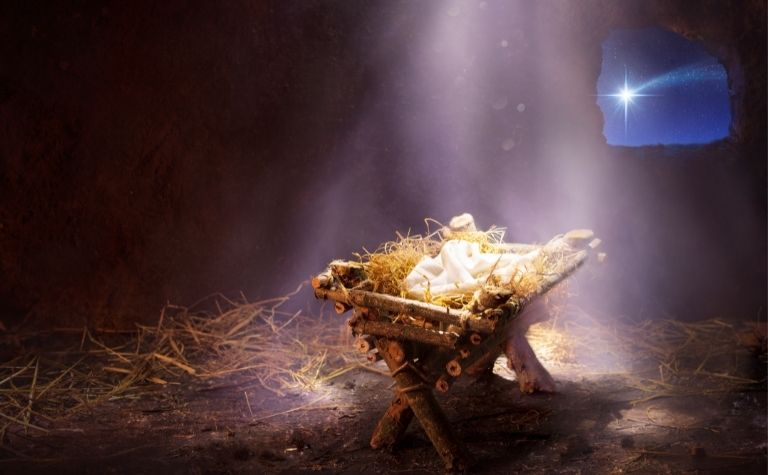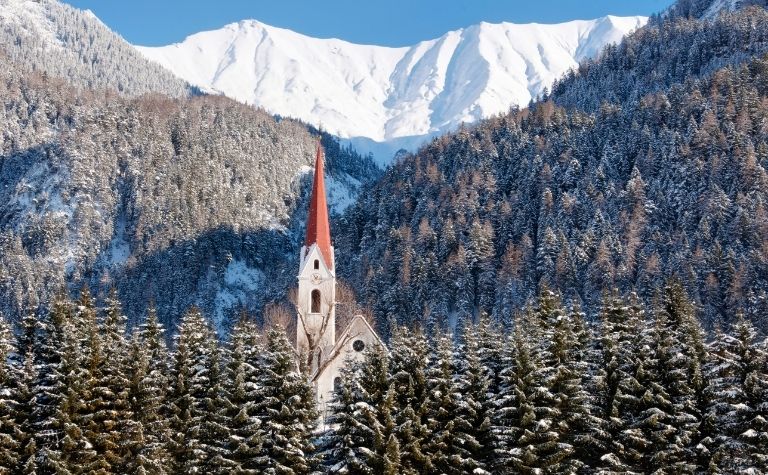The beloved Advent hymn Silent Night invites people to the manger in Bethlehem, where a young woman gave birth to a baby boy. The night is full of peace, joy, and love.
Worshipers are encouraged to consider the obedience of Mary, the reverential fear of the shepherds, and of course, the Lordship of the child swaddled in cloths, who is perhaps sending sounds of cooing or crying into the world he himself created (Col. 1:16).
The theme of Silent Night is the incarnation of God in the person of Jesus Christ. The word “incarnation” means “in the flesh” and refers to the second member of the Trinity becoming a human being.
John explains that “the Word became flesh and dwelt among us, and we have seen his glory, glory as of the only Son from the Father, full of grace and truth” (John 1:14, ESV).
Also see Christmas Advent Hymns: 151 Classics for more.

Lyrics to the Advent Hymn Silent Night Holy Night
The setting of the hymn is the birthday of Jesus of Nazareth. It opens with a reflection on Mary and her newborn baby boy. In the still of the night, God entered the world he created and sleeps peacefully with his young mother.
“Round yon virgin” means “around Mary.” In other words, all is calm and bright around Mary.
The second part of Silent Night mentions the shepherd and the angels. For reasons the world can’t understand, the baby boy causes heaven and earth to kneel in worship and adoration.
The third part of the hymn encourages worshipers to reflect on the love, grace, and Lordship of Christ.
| 1 Silent night, holy night! All is calm, all is bright round yon virgin mother and child. Holy Infant, so tender and mild, sleep in heavenly peace, sleep in heavenly peace. |
| 2 Silent night, holy night! Shepherds quake at the sight. Glories stream from heaven afar, heav’nly hosts sing, Alleluia! Christ, the Savior, is born! Christ, the Savior, is born! |
| 3 Silent night, holy night! Son of God, love’s pure light radiant beams from thy holy face with the dawn of redeeming grace, Jesus, Lord, at thy birth, Jesus, Lord, at thy birth. |
Pastor Alan Redpath writes, “The immense step from the Babe at Bethlehem to the living, reigning triumphant Lord Jesus, returning to earth for his own people– that is the glorious truth proclaimed throughout Scripture. As the bells ring out the joys of Christmas, may we also be alert for the final trumpet that will announce his return, when we shall always be with him.”
Also see O Little Town of Bethlehem for more.

Story of Silent Night Holy Night
In the small, quiet town of Oberndorf, Austria, on a snowy Christmas Eve, a priest and an organist wrote what is now the most beloved Christmas carol world-wide.
Stories abound as to the exact circumstances of the hymn’s origin, and there are societies dedicated to the task of protecting the authentic hymn text and story. If you ever visit Bronner’s Christmas Wonderland in Frankenmuth, Michigan, you can visit a replica of the Silent Night Chapel.
Movies and operas revolve around the hymn, and almost every recording artist that has ever made a Christmas album has recorded it. In a sense, this spreading of the Word is a joy. But these honors should also make us wary.
Paul Westermeyer writes, “Partly because of its popularity, STILLE NACHT can easily point to itself rather than beyond itself to the Word” (Let the People Sing, 153).
It is important, then, to not simply listen to what we might consider a quaint, nostalgia-evoking carol, but to sing out the depth of these words. For the “dawn of redeeming grace” is something far greater and grander than any song we could ever write. (From hymnary.org)
Also see Hark! The Herald Angels Sing for more.

Advent: Meaning, Dates, and History
The word “Advent” comes from the Latin word Adventus, meaning a “coming” or “arrival.” It describes the ecclesiastical season immediately before Christmas.
In the Western world, Advent Sunday, i.e. the first day of Advent, is the Sunday nearest to Saint Andrew’s Day (i.e. Nov. 30). Four Sundays in Advent precede Christmas Day. In the East, Advent is longer, beginning in the middle of November.
Advent Sunday is traditionally the day on which the ecclesiastical year begins. The first clear references to the season in the West come from the latter half of the 6th century.
Advent is observed as a time or preparation for Christmas like Lent is for Easter.
Also see The First Noel for more.
Bible verses related to the hymn for Advent
- Psalm 46:10, “Be still, and know that I am God. I will be exalted among the nations, I will be exalted in the earth!”
- Isaiah 7:14, “Therefore the Lord himself will give you a sign. Behold, the virgin shall conceive and bear a son, and shall call his name Immanuel.”
- Matthew 1:23, “Behold, the virgin shall conceive and bear a son, and they shall call his name Immanuel” (which means, God with us).”
- Luke 1:35, “And the angel answered her, ‘The Holy Spirit will come upon you, and the power of the Most High will overshadow you; therefore the child to be born will be called holy—the Son of God.'”
- John 1:1, “In the beginning was the Word, and the Word was with God, and the Word was God.”
- John 1:14, “And the Word became flesh and dwelt among us, and we have seen his glory, glory as of the only Son from the Father, full of grace and truth.”
- Galatians 4:4, “But when the fullness of time had come, God sent forth his Son, born of woman, born under the law”
Please see related articles below

Related Articles
The identity of the baby boy born in the humble town of Bethlehem to an unassuming young woman shocked the world. In that little boy, God became a man. He took on human flesh to save people from...
The Christmas season is full of festive music like the beloved Advent hymn, O Come, O Come, Emmanuel. Like the biblical stories that tell about the birth of Jesus Christ, the songs of Advent contain...
